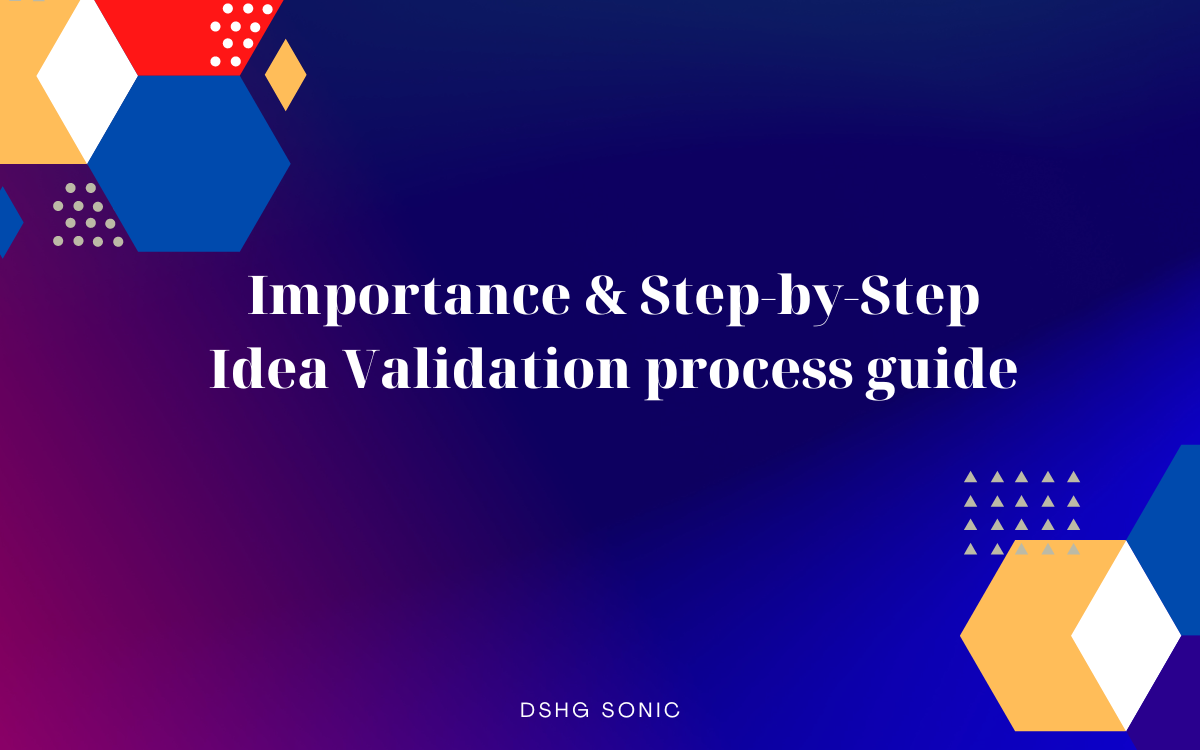Starting a business is an exciting journey, but it can be a daunting task. One of the most important aspects of launching a new startup is validation. Validation is the process of testing your business idea to determine if there is a need for your product or service in the market. You must validate your idea to save time and resources on a product no one wants. This article will discuss the importance of validation for startups and provide a step-by-step guide to the validation process.
Table of content
- Understanding the Necessity of Validation for Startups
- Examining the Steps in the Validation Process
- Developing a Solid Validation Plan for Startups
- Identifying Key Elements of the Validation Process
Understanding the Necessity of Validation for Startups
Starting a new business can be exciting, but it can also be daunting. Valuing your business idea is essential to ensure you’re on the right track. Validation is testing your assumptions and learning more about your market. It involves gathering feedback from potential customers and analyzing data to determine if your idea has the potential to succeed.
Validating your business idea is crucial because it allows you to understand your target audience and their needs. Doing so can refine your product or service to suit their preferences better. This, in turn, can increase the chances of success for your business.
Additionally, validation gives you valuable feedback that can help you improve your offering and attract more customers. By listening to your potential customers, you can identify areas that need improvement and make changes accordingly. This can help you create a better product or service that meets the needs of your target market.
Without validation, you may end up wasting valuable time and resources building a product or service that doesn’t appeal to your target market. This can be detrimental to your business, as it can lead to a lack of interest and, ultimately, failure. Even worse, you could launch a product that nobody wants, which can cripple your business before it even gets off the ground.
Validation can take many forms, such as surveys, focus groups, and market research. By utilizing these methods, you can gain valuable insights into your target market and make informed decisions about your business. It’s important to remember that validation is an ongoing process and should be done at various stages of your business’s development.
Examining the Steps in the Validation Process
Validation is an essential process that helps businesses ensure that their products or services meet the needs of their target audience. It is a crucial step in product development that can save businesses time and money in the long run.
Now that we understand the importance of validation let’s take a closer look at the steps involved in the process:
- Define your target audience: The first step in the validation process is to define your target audience. You need to know who you are targeting and what their needs are. This step is critical because it will help you tailor your product or service to meet the specific needs of your target audience.
- Create a value proposition: Once you have defined your target audience, the next step is to develop a clear and concise value proposition that explains the benefits your product or service provides to your target audience. Your value proposition should be compelling and address the pain points of your target audience. This step is crucial because it will help you differentiate your product or service from your competitors.
- Test your assumptions: Once you have a value proposition, you need to test your assumptions by talking to potential customers and getting feedback on your idea. This step is critical because it will help you validate your assumptions and ensure that your product or service meets the needs of your target audience. You can conduct surveys or interviews to gather feedback from your potential customers.
- Develop a prototype: Based on your feedback, you can develop a prototype or minimum viable product (MVP) that you can test with potential customers. A prototype is a working model of your product or service that you can use to test its functionality and usability. This step is essential because it will help you identify flaws or issues with your product or service before launching it.
- Test your product: Once you have developed a prototype, it’s time to test your product or service with your target audience to collect data on its performance, usability, and appeal. You can conduct user testing sessions to gather feedback from your target audience. This step is crucial because it will help you identify issues with your product or service and make necessary improvements.
- Analyze data and refine your offering: After testing your product or service, it’s time to analyze the feedback and data you have collected from your test group. Use this data to refine your product or service offering. This feedback should be used to guide changes and improvements to your MVP. This step is crucial because it will help you create a product or service that meets the needs of your target audience and is more likely to succeed in the market.
By following these steps, you can ensure that your product or service meets the needs of your target audience and is more likely to succeed in the market. Validation is an ongoing process, and you must continue testing and refining your offering to stay ahead of the competition.
Developing a Solid Validation Plan for Startups
Developing a solid validation plan is crucial for startups, and it can help you save time and money by ensuring that you are building something people want. To create an effective strategy, you need to understand your target market and their needs clearly. This means extensive research to identify your ideal customer and their pain points.
One way to gather information about your target market is through surveys and interviews. You can use online tools like SurveyMonkey or Typeform to create surveys and distribute them to your target audience. You can also contact potential customers and schedule interviews to learn more about their needs and challenges.
Once you understand your target market, you should identify the key assumptions you are making about your product or service. These assumptions could be related to the features, pricing, or target market. Once you have identified these assumptions, you can develop a strategy for testing them.
There are many ways to test assumptions, including creating prototypes, conducting A/B tests, and running focus groups. It’s essential to choose the most appropriate method for your product or service and your target market. For example, if you are developing a mobile app, you may want to create a prototype and conduct user testing to gather feedback on the user experience.
It’s essential to keep in mind that validation is an ongoing process. Even after you launch your product, you should continue to gather customer feedback and improve your offering to ensure that it remains relevant and valuable. This could involve adding new features, improving the user experience, or even pivoting to a new market.
By developing a solid validation plan, you can increase your chances of success as a startup. You can ensure that you are building something people want and avoid wasting time and resources on something that doesn’t meet the needs of your target market. So, take the time to research your target market, identify your key assumptions, and develop a strategy for testing them. Your startup will thank you for it!
If you need an assistant to guide you, we do offer a free discovery call to get started!
Identifying Key Elements of the Validation Process
Starting a new business can be daunting, but having a solid validation process can help minimize the risks and increase your chances of success. A validation process is a series of steps to test your business idea and determine if there is a market for your product or service.
Now that we’ve covered the basics of the validation process, let’s take a closer look at some of the critical elements:
- Customer discovery: The process of identifying your target audience and their needs. This involves conducting market research to gain a deeper understanding of your potential customers, including their demographics, behaviors, and pain points. By understanding your customers, you can tailor your product or service to meet their needs and increase your chances of success.
- Customer validation: The process of testing your assumptions with potential customers to determine if there is a need for your product or service. This involves reaching out to your target audience and gathering feedback on your business idea. By validating your assumptions, you can refine your product or service to meet your customers’ needs better.
- Product development: The process of developing a prototype or MVP based on the feedback you receive from customer validation. This involves creating a minimum viable product (MVP) that can be tested with your target audience. Developing a prototype allows you to test your product or service in a real-world setting and gather valuable feedback.
- Product validation: The process of testing your product or service with your target audience to evaluate its performance and appeal. This involves conducting user testing and gathering feedback on your MVP. By validating your product, you can refine it to better meet the needs of your customers.
- Data analysis: Analyzing the feedback and data you collect from your tests to guide changes and improvements to your product or service offering. This involves gathering and analyzing data on customer behavior, market trends, and user feedback. Analyzing this data lets you make informed decisions about improving your product or service offering.
Following these essential elements can create a thorough and effective validation process for your startup. This will help you to minimize the risks associated with starting a new business and increase your chances of success.
Conclusion
Validation is a vital step in the startup process. It allows you to test your business idea, collect valuable feedback, and refine your offering to suit your target audience’s preferences better. By following the steps outlined in this article and identifying the critical elements of the validation process, you can create a solid plan for validating your startup idea and set yourself up for success.
As the premier idea validation company in Florida, we are dedicated to helping entrepreneurs like you turn their big ideas into profitable ventures. With our expert guidance and cutting-edge methods, we’ll help you evaluate your idea’s potential, identify any weaknesses, and fine-tune your approach for maximum success.
So, if you’re ready to take your idea to the next level, look no further than our top-rated idea validation services.
Connect us here and learn more!









